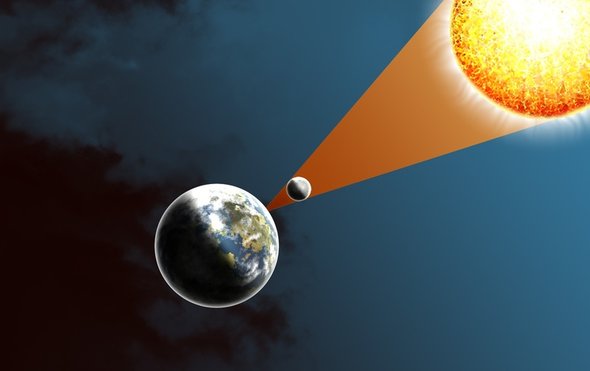(单词翻译:单击)
听力文本
This is Scientific American — 60-Second Science. I'm Karen Hopkin.
Where were you on August 21, 2017? If you're like me—and a couple hundred million other Americans—you were watching the total eclipse of the sun. (Sound of Karen Hopkin and her group viewing the eclipse)
It was breathtaking. Mind-blowing. Awesomely spectacular—and potentially educational. Because a new study shows that folks who saw the celestial event sought information on solar eclipses about 16 times both before and after the big day.
In the U.S., some 216 million adults viewed the eclipse. That's 88 percent of the adult population. This viewership dwarfs that of the Superbowl and ranks among the most watched events in American history. That's according to the Michigan Scientific Literacy Survey of 2017.
Jon Miller of the University of Michigan conducts a national study of Americans' scientific know-how twice a year. But last year, he added another survey over the week or two after the eclipse, while the experience was still fresh.
He discovered that in the months prior to the eclipse, there was a flurry of interest in the phenomenon. People searched online for eclipse-related information and talked about it with family and friends.
And the nearly 20 million who traveled to see the eclipse were even more hungry for heavenly knowledge, averaging nearly 25 episodes of eclipse-related information seeking. In comparison, those who for whatever reason missed the event only reported reading or chatting about it six times.

But the interest didn't end with the sun's reappearance. After the event, people kept on reporting online-learning and continued conversations.
Miller's survey also indicates that by the end of 2017, 70 percent of those questioned were able to explain the meaning of a total solar eclipse. That's a considerable step up from the 50 percent who understood what an eclipse was at the beginning of the year. Even people who didn't see the eclipse were more likely to correctly define it by year's end, suggesting that the media coverage and general hubbub rubbed off.
However, the eclipse mania did not appear to boost our overall understanding of the relationship of the Earth and the sun. The percentage of respondents who knew that the Earth circles the sun once each year remained essentially unchanged, at around 64 percent. These findings should give science communicators added incentive to get the word out before the next big North American eclipse: April 8, 2024.
Thanks for listening for Scientific American — 60-Second Science. I'm Karen Hopkin.
参考译文
这里是科学美国人——60秒科学。我是凯伦·霍普金。
2017年8月21日你在哪里?如果你像我以及其他两亿美国人一样,那你当时在观看日全食。(凯伦·霍普金和她的团队观看日全食的声音)
这次日全食摄人心魄、令人震惊、蔚为壮观,而且可能还具有教育意义。因为一项新研究表明,在日全食前后,观看这一天文现象的人搜索了约16次日全食信息。
在美国,有约2.16亿成年人观看了日全食。这一人数占全美成年人总数的88%。日全食观看人数令超级碗观众数量相形见绌,成为美国历史上观看人数最多的事件之一。这一数据来自《2017年密歇根科学素养调查》。
密歇根大学乔恩·米勒每年对美国人的科学知识进行两次全国性研究。但是去年,在日全食结束的一或两周之后,他又增加了一次调查,此时观看日全食的体验还处于新鲜阶段。
他发现,在日全食发生前的几个月里,人们对这种现象的兴趣开始激增。人们会在网上搜索与日全食有关的信息,并与家人和朋友进行讨论。
而近2000万赶来观看日全食的人甚至更渴加渴求天文知识,平均每人会搜索近25次与日全食有关的信息。相比之下,报告显示,那些因为种种原因而错过日全食的人浏览或谈起这一事件的次数只有6次。
但人们对日全食的兴趣并没有随着太阳的重现而结束。日全食之后,人们仍继续报告他们在网上学习相关信息,并继续谈论此事件。
米勒的调查还表明,截至2017年底,有70%的受访者能解释日全食的含义。这是相当大的进步,年初只有50%的受访者了解什么是日全食。年底时,即使是那些没有观看日全食的人都更可能给出正确的定义,这表明了媒体报道和公众热议的影响。
然而,日全食热似乎并没有增加我们对地球与太阳关系的整体理解。受访者中知道地球每年绕太阳公转一周的比例基本没变,仍为64%左右。下一次北美大型日全食将在2024年4月8日发生,而在那之前,这些发现应该能增加科学传播者宣传这一天文现象的动力。
谢谢大家收听科学美国人——60秒科学。我是凯伦·霍普金。
译文为可可英语翻译,未经授权请勿转载!
重点讲解
重点讲解:
1. prior to 在…之前;先于;
Just phone in your order three or more days prior to departure.
在出发的三天之前打电话预订即可。
2. be hungry for 渴望的;热望的;
Susan was certainly hungry for a life different from the one she had made for herself.
苏珊无疑一心想过一种和现在不同的生活。
3. in comparison 与…相比;与…比较而言;
In comparison, only 10% of people said they are likely to lie to their partner.
相比而言,只有10%的人说他们会对伴侣撒谎。
4. keep on 重复;继续;
My wife keeps on saying that I work too hard.
我妻子总说我工作太辛苦了。


